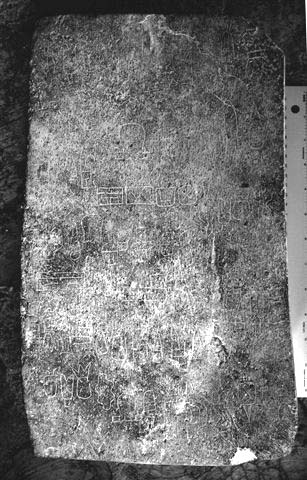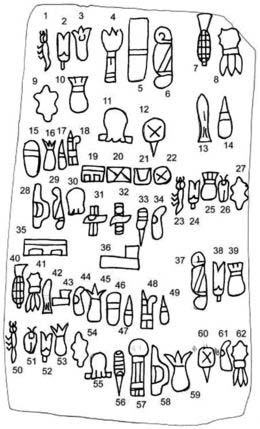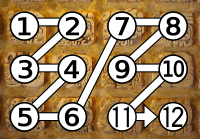Due to the recent 2012 emotions (& a very bad movie :), I'll try to give here a short and easy overview of the real Maya calendar and the Mayan script that were in "official" use from (at least) the 3rd century BC until AD 1697. It begins with an introduction to the Mesoamerican setting in which script and calendar evolved.
Vanwege de recente 2012 "perikelen" (en een bijzonder slechte film ;), zal ik proberen hier een klein overzichtje te geven van de echte Mayakalender, hun schrift ("officieel" in gebruik van de 3de euw voor Chr. tot 1697 na Chr.) en, om mee te beginnen, een kleine introductie van de Mesoamerikaanse wereld waarin schrift en kalender ontstonden.
Porque había muchas emociones recientemente (ya estamos en 2010! Solamente dos años antes el año 2012!!) y una película horrible, comenzaré aquí con una descripción pequeña al calendario y escritura maya (la escritura que era "oficial" a partir del tercer siglo a.C. hasta 1697 d.C.). También daré una introducción del mundo mesoamericano en el cual los dos originaron.
Mesoamerica writing(s) and calendar(s)
 In Mesoamerica (by most specialists described as the southern half of Mexico, Guatemala, Belize, and the western/northern parts of Belize, Honduras, Nicaragua, and Costa Rica) writing probably started somewhere between 1000 and 500 BC. There is much debate about "the first" & "the first true" writing, especially after the 2006 discovery of the so called Cascajal Block.
In Mesoamerica (by most specialists described as the southern half of Mexico, Guatemala, Belize, and the western/northern parts of Belize, Honduras, Nicaragua, and Costa Rica) writing probably started somewhere between 1000 and 500 BC. There is much debate about "the first" & "the first true" writing, especially after the 2006 discovery of the so called Cascajal Block.Cascajal Block (+/-950BC): first mesoamerican writing?
Mesoamerica is home to many different  native nations. The Mayas and Aztecs are the two famous ones but most people don't realize that they don't have much in common (except that both are living in what today is Mexico). Their language is completely different (and of course also very different from Spanish) as well as their cultures. Most interseting perhaps is that the Aztecs are much "younger" as a culture than "the Mayas". When the Spaniards arrived in 1519, the Aztec empire was not even a century old while "Maya culture" on the other hand, was already +/- 2000 years old by then.
native nations. The Mayas and Aztecs are the two famous ones but most people don't realize that they don't have much in common (except that both are living in what today is Mexico). Their language is completely different (and of course also very different from Spanish) as well as their cultures. Most interseting perhaps is that the Aztecs are much "younger" as a culture than "the Mayas". When the Spaniards arrived in 1519, the Aztec empire was not even a century old while "Maya culture" on the other hand, was already +/- 2000 years old by then.
 native nations. The Mayas and Aztecs are the two famous ones but most people don't realize that they don't have much in common (except that both are living in what today is Mexico). Their language is completely different (and of course also very different from Spanish) as well as their cultures. Most interseting perhaps is that the Aztecs are much "younger" as a culture than "the Mayas". When the Spaniards arrived in 1519, the Aztec empire was not even a century old while "Maya culture" on the other hand, was already +/- 2000 years old by then.
native nations. The Mayas and Aztecs are the two famous ones but most people don't realize that they don't have much in common (except that both are living in what today is Mexico). Their language is completely different (and of course also very different from Spanish) as well as their cultures. Most interseting perhaps is that the Aztecs are much "younger" as a culture than "the Mayas". When the Spaniards arrived in 1519, the Aztec empire was not even a century old while "Maya culture" on the other hand, was already +/- 2000 years old by then.The Mayas weren't the only ones to invent a script. Nor were they the first. The Cascajal Block (if genuine) in about 500 years older than the first Mayan writings and looks nothing like it.
Calendar: counting
The Mesoamerican calendar was, simply said, based on lunar and solar features, just like almost every modern calendar (be it Christian, Muslim, Jewish, Hindu, etc). In its basic form it is one single system, but the easiest way to explain it is to separate it in two. This is what specialists call the Long Count (started at a particular point in time), and the Short one (a system that rotates). Compare this with the modern Gregorian Calendar most people use today. That one has a "Long Count" which starts with the birth of Christ, and a "short" one, that starts the 1st of January, and ends on the 31st of December, only to begin again on the 1st of January.
Thus, the date: 25/12/2009 (or 12/25/2009) is a single date with "two" counting systems in it. It's the 25th day of December (a day that returns every 365 days), in the year 2009 after Christ (a date/year that appears only once).
There even is a third "short count" in the Gregorian calender: the week. A week has seven days, and after the seventh, the first one reappears. In the mean time however, this is also a "long" count, since the first Monday (let's say: Monday the first) is not exactly the same as the following one (Monday the eighth). Then again, a "Monday the first" may well reappear later, in another month or year.
So, just like the Maya/Mesoamerican one, the Gregorian calender is ONE calender with different counting systems.
Maya counting
First something has to be said about the numbers people used. Of course the different cultures used different signs to annotate numbers, but they all used some basic forms.
A dot . represented 1
A bar __ was used to annotate 5
2 dots meant two, 2 bars was 10. Etc... More was not needed. There also was a zero (which was quite unique in the world and invented in the centuries before christ).
The Mayan system

In our system (which the West borrowed from the Arabs/Hindus), 56, actually is 5 tens ("fif-ty" in English: "fif' = 5, "ty" = 10) + 6. The number 83: 8 times 10 + 3 ("eigh"-"ty" + three)". This means we have a base 10 system.
In French (from France) however 83 is with base 20: 4 times 20 + 3 ("quatre-vingt -trois"). This way of counting numbers (in Europe still in use in the Celtic languages) was the normal way of counting in Mesoamerica. We count in tens, and after that:
10 x 10 (100)
10 x 10 x 10 (1000)
10 x 10 x10 x 10 (10.000)
etc
In Mesoamerica they did the same with 20:
20 x 20 = 400 (they actually used 20 x 18 = 360 here, for the reason see below)
20 x 20 x 18 = 7200
20 x 20 x 20 x 18 = 144.000
20 x 20 x 20 x 20 x 18 = 2.880.000
So, with this basic kind of maths, plus the help of the "number" zero, people could add, subtract, and multiply numbers quite easily. An example can be seen here. To write down 5209, the Mayans did this:

That's 13 times 400 (5200) + 0 times 20 (0) + 9.
Maya calender
These basic numbers got their own "day names". We don't know all the original ones, and some Mayan ones got a new "Mayanist" name. To give the 5 most common:
1 day = K'IN (original name, meaning: Sun)
20 days (= 20 K'ins) = WINAL
360 days = 18! Winals = 1 TUN (they took 18 instead of 20 because 360 is almost a solar year)
20 Tuns = 360 days x 20 = 7200 days = 1 KATUN
20 Katuns = 7200 days x 20 = 144.000 days = 1 BAKTUN
Calendar: two in one
Like I said above, although there was one basic calendar, it's much more easy to explain it as if there were two: a Long Count, and a "short" one. To begin with the "short" one.
The "short" one was the one most used, in almost all Mesoamerican cultures. Again we can devide it in two, a "solar" count (365 days, now called Haab in the Maya calendar), and a "lunar" count (260 days, now called Tzolk'in in the Maya calendar). Since 20 was the number to work with, the 365 days were devided into 18 "months" of 20 days (360 : 20 = 18) + another "month" of 5 extra days. The Tzolk'in 260-days count was devided into 13 times 20 day signs (260 : 20 = 13).
An example for the Tzolk'in count:
When we combine the 20 lunar days (I give them here the names A to T) with the numbers, 1 to 13 , and we get this:
A1, B2, C3, D4, E5, F6, G7, H8, I9, J10, K11, L12, M13, and then (since we only have 13 numbers)
N1, followed by O2, P3, Q4, R5, S6, and T7. After that we have exhausted all 20 day signs, so we are back with A. So the next one is A8, followed by B9, C10, D11, E12, F13, and... G1, etc, etc, until all combinations have been tried and we're back with A1. That is after 260 days...
Interpolating the Haab and Tzolk'in (other peoples, like the Aztecs, of course used other names) calendars, the Mesoamericans created a time cycle of 52 years (18.980 days), which is called the Calendar Round. Again, all combinations are used then, and we can start all over again. This is what we can compare with a century.
With all this information people (mostly priests and nobility of course) could calculate with huge numbers. The nobles could also commemorate important events, like battles, or festivities.
Writing
The Mesoamerican calendar was, simply said, based on lunar and solar features, just like almost every modern calendar (be it Christian, Muslim, Jewish, Hindu, etc). In its basic form it is one single system, but the easiest way to explain it is to separate it in two. This is what specialists call the Long Count (started at a particular point in time), and the Short one (a system that rotates). Compare this with the modern Gregorian Calendar most people use today. That one has a "Long Count" which starts with the birth of Christ, and a "short" one, that starts the 1st of January, and ends on the 31st of December, only to begin again on the 1st of January.
Thus, the date: 25/12/2009 (or 12/25/2009) is a single date with "two" counting systems in it. It's the 25th day of December (a day that returns every 365 days), in the year 2009 after Christ (a date/year that appears only once).
There even is a third "short count" in the Gregorian calender: the week. A week has seven days, and after the seventh, the first one reappears. In the mean time however, this is also a "long" count, since the first Monday (let's say: Monday the first) is not exactly the same as the following one (Monday the eighth). Then again, a "Monday the first" may well reappear later, in another month or year.
So, just like the Maya/Mesoamerican one, the Gregorian calender is ONE calender with different counting systems.
Maya counting
First something has to be said about the numbers people used. Of course the different cultures used different signs to annotate numbers, but they all used some basic forms.
A dot . represented 1
A bar __ was used to annotate 5
2 dots meant two, 2 bars was 10. Etc... More was not needed. There also was a zero (which was quite unique in the world and invented in the centuries before christ).
The Mayan system

In our system (which the West borrowed from the Arabs/Hindus), 56, actually is 5 tens ("fif-ty" in English: "fif' = 5, "ty" = 10) + 6. The number 83: 8 times 10 + 3 ("eigh"-"ty" + three)". This means we have a base 10 system.
In French (from France) however 83 is with base 20: 4 times 20 + 3 ("quatre-vingt -trois"). This way of counting numbers (in Europe still in use in the Celtic languages) was the normal way of counting in Mesoamerica. We count in tens, and after that:
10 x 10 (100)
10 x 10 x 10 (1000)
10 x 10 x10 x 10 (10.000)
etc
In Mesoamerica they did the same with 20:
20 x 20 = 400 (they actually used 20 x 18 = 360 here, for the reason see below)
20 x 20 x 18 = 7200
20 x 20 x 20 x 18 = 144.000
20 x 20 x 20 x 20 x 18 = 2.880.000
So, with this basic kind of maths, plus the help of the "number" zero, people could add, subtract, and multiply numbers quite easily. An example can be seen here. To write down 5209, the Mayans did this:

That's 13 times 400 (5200) + 0 times 20 (0) + 9.
Maya calender
These basic numbers got their own "day names". We don't know all the original ones, and some Mayan ones got a new "Mayanist" name. To give the 5 most common:
1 day = K'IN (original name, meaning: Sun)
20 days (= 20 K'ins) = WINAL
360 days = 18! Winals = 1 TUN (they took 18 instead of 20 because 360 is almost a solar year)
20 Tuns = 360 days x 20 = 7200 days = 1 KATUN
20 Katuns = 7200 days x 20 = 144.000 days = 1 BAKTUN
Calendar: two in one
Like I said above, although there was one basic calendar, it's much more easy to explain it as if there were two: a Long Count, and a "short" one. To begin with the "short" one.
The "short" one was the one most used, in almost all Mesoamerican cultures. Again we can devide it in two, a "solar" count (365 days, now called Haab in the Maya calendar), and a "lunar" count (260 days, now called Tzolk'in in the Maya calendar). Since 20 was the number to work with, the 365 days were devided into 18 "months" of 20 days (360 : 20 = 18) + another "month" of 5 extra days. The Tzolk'in 260-days count was devided into 13 times 20 day signs (260 : 20 = 13).
An example for the Tzolk'in count:
When we combine the 20 lunar days (I give them here the names A to T) with the numbers, 1 to 13 , and we get this:
A1, B2, C3, D4, E5, F6, G7, H8, I9, J10, K11, L12, M13, and then (since we only have 13 numbers)
N1, followed by O2, P3, Q4, R5, S6, and T7. After that we have exhausted all 20 day signs, so we are back with A. So the next one is A8, followed by B9, C10, D11, E12, F13, and... G1, etc, etc, until all combinations have been tried and we're back with A1. That is after 260 days...
Interpolating the Haab and Tzolk'in (other peoples, like the Aztecs, of course used other names) calendars, the Mesoamericans created a time cycle of 52 years (18.980 days), which is called the Calendar Round. Again, all combinations are used then, and we can start all over again. This is what we can compare with a century.
With all this information people (mostly priests and nobility of course) could calculate with huge numbers. The nobles could also commemorate important events, like battles, or festivities.
Writing


Geen opmerkingen:
Een reactie posten